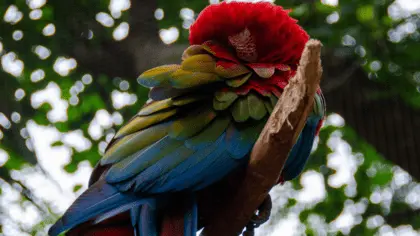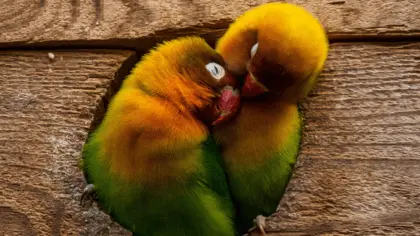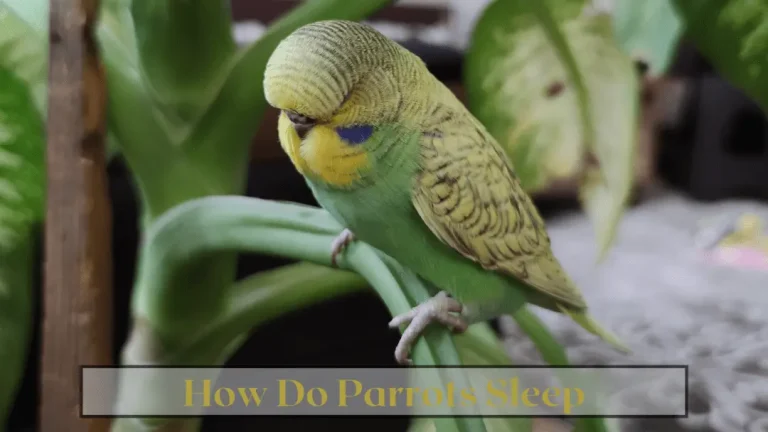Parrots are remarkable creatures that capture the attention of many people with their vivid colors, playful personalities, and impressive vocalizations. While these traits are widely known, many lesser-known facts exist about these birds, including their sleeping patterns. Parrots have a unique way of sleeping, unlike humans and other animals, including various sleeping positions that differ from one species to another.
In this article, we will delve deeper into the sleeping habits of parrots, exploring ten common sleeping positions and what they can reveal about the fascinating world of parrots.
How Do Parrots Sleep?

Parrots sleep differently than humans and many other animals. While humans have a single, consolidated sleep period at night, parrots have a polyphasic sleep pattern, meaning they sleep in multiple short bursts throughout the day and night.
During sleep, parrots often perch on one leg with their head tucked under their wing. They may also sleep while standing on both legs or perching on a branch or other object. Some parrots prefer to sleep in a cozy nesting box or sleeping tent, especially if they are trying to stay warm.
10 Common Parrot Sleeping Positions

1. Standing position
Parrots may sleep while standing, particularly when they feel secure and comfortable in their environment. This position is common in wild parrots that roost on tree branches or other sturdy structures. When standing, the parrot may rest one foot at a time, switching between each foot. Some parrots may even sleep with their beaks tucked into their backs, making them appear as if they are dozing off.
2. One-leg up
Parrots have a unique way of sleeping, with one leg raised. They tend to tuck one leg up and hold it against their body while they sleep. This position is seen in parrots that prefer to perch on branches or other structures, as it helps them to balance their weight while sleeping. Depending on the bird’s preference, the raised leg may be tucked under the body or held out to the side.
3. Both legs tucked under the body
In this position, the parrot tucks both legs under its body and rests its weight on its belly. This is a common position for birds that prefer sleeping in a nest or enclosed space. This position is also common in parrots that prefer to sleep on their backs, as it allows them to rest comfortably while keeping their body warm.
4. Perching with head tucked under the wing
Parrots may also sleep by perching on a branch or other structure with their head tucked under their wing. This position allows them to rest their neck muscles and provides a sense of security while they sleep. Some parrots may even wrap their wings around their body while sleeping, creating a warm and comfortable environment.
5. Perching with head resting on back
In this position, the parrot perches on a branch or other structure with its head resting on its back. This position is commonly seen in parrots that prefer to sleep while standing up. The parrot may tuck one leg up and rest its weight on the other while sleeping.
6. Perching with one eye closed
Parrots may sleep with one eye closed and one open, particularly when they feel vulnerable or insecure. This position allows them to remain alert while getting the rest they need. This position is commonly seen in parrots in captivity, as they may feel more vulnerable than their wild counterparts.
7. Perching with both eyes closed
In this position, the parrot perches on a branch or other structure with both eyes closed. This position is a clear indication that the parrot is sleeping and feeling safe and secure in its environment. The parrot may tuck one leg up and rest its weight on the other while sleeping.
8. Hanging upside down
Some parrots may sleep while hanging upside down from a branch or other structure. This position may seem uncomfortable to humans, but it is a natural sleeping position for some parrots, particularly those that live in the wild. This position allows them to rest their wings and neck muscles while remaining alert to potential threats.
9. Lying on back
Parrots may also sleep while lying on their back, particularly when they feel safe and comfortable. This position is commonly seen in parrots that prefer to sleep in a nest or enclosed space. This position allows the parrot to rest and keep warm while sleeping.
10. Sleeping in a nest or enclosed space
Many parrots prefer to sleep in a nest or enclosed space, particularly those kept in captivity. This position gives them a sense of security and privacy while sleeping. Some parrots may even cover themselves with a blanket or other soft material while sleeping, creating a warm and comfortable sleeping environment.
Things To Consider For Your Parrot’s Sound Sleep

Parrots require sound sleep for their physical and emotional well-being. Lack of proper sleep can lead to behavioral problems, stress, and health issues. Therefore, creating a comfortable and suitable sleeping environment for your parrot is crucial. Here are some things to consider for your parrot’s sound sleep:
Location
The cage’s location should be quiet and peaceful. Parrots are sensitive to noise and disturbance; noise in the surrounding environment can disrupt their sleep. Avoid keeping the cage in a high-traffic area, near the TV or radio, or close to windows that face busy streets.
Lighting
Parrots need darkness to sleep. Covering the cage with light blocking can help create a dark and cozy environment. However, ensuring that the covering material does not block the cage’s ventilation and that the parrot has enough fresh air is essential.
Temperature
Parrots prefer a warm and cozy environment for sleeping. The temperature in the room should be between 65- and 75 degrees Fahrenheit. If the temperature drops below this range, provide a heating source such as a heating pad or a heat lamp.
Bedding
Choose a comfortable and safe bedding material for the cage. Avoid using materials that produce dust, such as cedar or pine shavings. Instead, use paper or cloth-based materials, such as plain newspaper or a soft towel.
Perches
Provide multiple perches of different sizes and textures in the cage. This allows the parrot to choose a comfortable perch for sleeping. Avoid using too thin or slippery perches, as they can cause foot problems.
Socialization
Parrots are social animals and prefer to sleep with their companions. If possible, consider keeping two parrots of the same sex together for sleeping. A study published on ResearchGate suggests that isosexual pair housing can improve parrots’ welfare by reducing stress levels and increasing positive social behaviors.
How long do pet parrots sleep?
Pet parrots require an average of 10-12 hours of sleep per day, although the amount of sleep they need can vary depending on their species, age, and environment. For instance, African Grey Parrots are light sleepers and may wake up easily if disturbed, while Eclectus Parrots are known to be deep sleepers and may not wake up easily. Amazon Parrots, Cockatiels, Budgerigars, Macaws, and Conures all need around 10-12 hours of sleep per day, and they all prefer to sleep in a quiet and dark environment.
Some parrots may cover their heads with their wings or feathers while sleeping, and others may fluff their feathers to keep warm. It is crucial to create a comfortable and suitable sleeping environment for your parrot and ensure they get enough sleep to maintain their physical and emotional well-being.
What Should Be The Ideal Place For Your Parrot’s Sleep?

As a parrot owner, ensuring that your feathered friend has a comfortable and safe place to sleep is important. Here are some ideal places for your parrot’s sleep:
A sleep cage
A smaller cage dedicated solely to the bird’s bedtime can be effective. Place the cage in a separate, quiet, dark room away from the family activities.
Walk-in hall cupboard
If you have limited space, dedicate a quiet walk-in hall cupboard for your bird’s sleep.
Room with maximum family interaction
When the bird is awake, keep it in the room where the family spends most of the time.
Cage coverings
If you have to keep your bird in a room where the lights are on, use a cage cover to ensure a dark environment for sleep. However, use them sparingly, as some birds may not prefer complete darkness.
Partly covered cage
Complete darkness may cause night frights for some birds. Leaving part of their cages uncovered and plugging in a night light can help.
Related Article: Best large bird cages
Do Parrots Need To Sleep At Night Or Day Also?
Yes, parrots do need to sleep at night and during the day. Like humans, parrots require restful and uninterrupted sleep to stay healthy and active.
In the wild, parrots are diurnal creatures, meaning they are active during the day and sleep at night. Therefore, it’s essential to maintain a consistent sleep schedule for your pet parrot, including adequate sleep during the night.
Most parrots need around 10 to 12 hours of sleep every day. It’s important to ensure that your parrot has a quiet, dark, and comfortable sleeping area to help them get the sleep they need.
However, parrots may also take short naps during the day, especially after meals or when tired. Providing a peaceful and undisturbed environment during nap time is also important to help them rest and recharge. Overall, your parrot must maintain a regular sleep schedule to promote their well-being and keep them healthy and happy.
Do Your Parrot Need A Bed For Sleeping? (within 80 words)

Parrots do not necessarily need a bed for sleeping, but they need a comfortable and safe resting place. Many parrots prefer sleeping on a perch, but providing a cozy nesting box or sleeping tent can also be beneficial. It is important to ensure that the sleeping area is not too bright or noisy and is quiet and draft-free. Additionally, parrots should have a consistent sleep schedule and be allowed to sleep for at least 10 hours per night to promote good health and well-being.
Signs of sleep deprivation in parrots
Parrots are intelligent and social birds that require adequate sleep for their well-being. Like humans, sleep deprivation can negatively affect their physical and mental health. Here are some signs of sleep deprivation in parrots:
- Feather plucking or chewing: A sleep-deprived parrot may start to pluck or chew their feathers excessively, which can lead to bald patches on their bodies.
- Irritability: If a normally friendly parrot starts to become agitated or aggressive, it may be a sign of sleep deprivation.
- Decreased activity: A sleep-deprived parrot may become lethargic and less active than usual.
- Poor coordination: Sleep deprivation can affect a parrot’s coordination and balance, making them more prone to accidents and injuries.
- Decreased appetite: A parrot not getting enough sleep may lose its appetite or become less interested in food.
- Excessive sleeping: Conversely, some parrots may try to compensate for lost sleep by sleeping excessively during the day.
- Lack of vocalization: A sleep-deprived parrot may become quieter than usual and not engage in typical vocalizations.
FAQs
1. Do parrots sleep through the night?
Parrots do not typically sleep through the entire night as humans do. Instead, they have a polyphasic sleep pattern and sleep in short bursts throughout the day and night.
2. Can parrots sleep while standing up?
Parrots can sleep while standing up, often perching on one leg with their head tucked under their wing. They may also sleep while standing on both legs or while perching on a branch or other object.
3. Do parrots need a lot of sleep?
Parrots require significant sleep to maintain their physical and mental health. They should be allowed to sleep for at least 10 hours per night to ensure they get the restful sleep they need.
4. Should I cover my parrot’s cage at night?
Covering a parrot’s cage at night can provide a dark and quiet environment that can be conducive to sleep. However, ensuring the cover is breathable and does not restrict airflow in the cage is important.
5. How can I create a comfortable sleeping environment for my parrot?
To create a comfortable sleeping environment for your parrot, provide a quiet, dark, and cozy area for them to rest. This can be a nesting box, sleeping tent, or a quiet corner of their cage. Make sure the sleeping area is located in a draft-free area and away from any noisy or disruptive activity.
Reference:
- https://www.sciencedaily.com/releases/2016/08/160803111738.htm
- https://www.exoticdirect.co.uk/news/parrots-and-sleeping
- https://www.birds.cornell.edu/k12/do-birds-sleep/
- https://www.parrotfunzone.com/learn-about-parrots/parrot-anatomy

Hi, I’m Regina Rios. Just another bird lover who loves to share knowledge from personal experience. I’ve grown up with pet birds since childhood as my mommy also loves birds. As I can’t pet many birds in open air in my house as my mom does; I created my first bird cage on my rooftop using wood, copper wire, and a metal shed in 2018 and start collecting pet birds. Now, I have so many pet birds such as Macaws, Parrot, Cockatiel, Parakeet, and others. Not only that, if I see natural birds are injured I keep them in my house until they get well. Now, my hobby becomes my income source as my home birds have babies and I sell them to birds lover like mine. I’ve created this blog to inspire others bird owners by sharing my personal knowledge. Good Luck!


